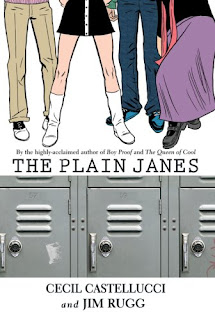PLOT:
A terrorist attack in Metro City forces
Jane and her parents to move to suburbia.
Jane is a teen that was a victim to this attack and helped save another
person who is called John Doe and is in a coma at the cities hospital. Forced to a fresh new start in a new high
school she makes friends with girls that are loners and rejects. However they are also named Jane, “Brain Jane”,
“Theatre Jane” and “Sporty Jane”. They
become good friends and start a group called P.L.A.I.N. This stands for People Loving Art in
Neighborhoods. The girls go around committing “art attacks” at night to try and
make the suburbs more cheerful since the terrorist attack left many people
scared. The Jane’s plan a ball dropping to celebrate New Year’s but things go
sour because the police are trying really hard to catch the group committing
these acts.
Castellucci, C. & Rugg, J. (2007). The plain Janes. New York, NY: DC
Comics.
IMPRESSION
OF THE BOOK:
I liked the story line it was simple and interesting. I really liked the different types of art
that they displayed. The art display
that I really liked the best is when the girls put hoodies and scarfs on the
fire hydrants. The other art display was
the messages in the bottles. They hung
bottles from a tree and put written messages inside the bottles. The messages were all different some said “Dance”,
“Hug” or just to express a great feeling by doing something. This book reminded me of the organized flash
mob dances that were occurring all over the different busy places a while
back. It was art and it was organized to
show some sort of emotion. I really
liked the way the teen girls united and worked together to do something fun. I honestly thought that everyone would show
up at the end to see the ball drop full of paint but it was sad that they
couldn’t leave the house party because the cops raided the party. I think the ball dropping would have really
brought joy to the city and to all the people there to symbolize a new year and
to try and forget the terrorist attack.
REVIEWS: The first entry in DC Comics new Minx line, Cecil Castellucci
& Jim Rugg's The Plain Janes is a well-intended piece of adolescent
lit whose modest charms threaten to be overwhelmed by its status as a
Significant Publishing Event: DC Comics' much-touted attempt at snagging the
long elusive tween- & teen-girl audience.
Janes' story is narrated by a city girl named Jane Beckles, who
survives a seemingly random terrorist bombing (writer Castellucci keeps the
details behind the attack vague, though an early visual reference to Orange
Alerts can't help but bring up thoughts of 9/11) as she's strolling past a
street-side café. Following this life-changing event, Jane dyes her hair black
and becomes a More Serious Person (though we're not really shown her past as a
frivolous blond). When her parents, freaked out by the newly perilous-seeming
city, move to suburban Kent Waters, our heroine has to find a new set of
friends as she's simultaneously working toward building a fresh identity.
She settles on a group of
"misfit" girls sitting together in the lunchroom: a bespectacled
science nerd, a pudgy drama type and a strapping girl jock – all of whom are
also named Jane (or a variation thereof). Though the threesome initially
rebuffs our girl's advances ("Even the reject table doesn't want to sit
with me," she grouses), Jane ultimately wins 'em over by proposing that
they band together as an Art Gang.
Her creation of this group, which
she calls P.L.A.I.N. for "People Loving Art in Neighborhoods," arises
from two moments that had occurred immediately after the bombing: the sighting
of a dandelion growing out of the sidewalk ("If that dandelion could
survive, so could I," Jane thinks) and her acquisition of an artist's
sketchbook dropped close to where she's fallen. On the sketchbook is the
legend, "Art Saves," and Jane takes this as her new personal credo.
With the other Janes, she creates works of guerilla art throughout the town of
Kent Waters, first being a trio of pyramids on the site of a proposed strip
mall: "The pyramids lasted thousands of years," the piece's poster
notes. "Do you think this strip mall will?"
Though Jane's stated intent is to
bring a moment of beauty into mundane suburban life, the response to the
P.L.A.I.N. Janes' work is decidedly mixed. To Jane's parents and the local
authorities, even something as harmless as an "art attack" serves as
a reminder of how tenuous their safety is. Instead of seeing the P.L.A.I.N.
statements for what they are – fairly obvious adolescent didacticism —
they react as if the terror alert's been just been upped. What started out as
an effort on Jane's part to bring a new sense of control to her life ("I
feel like I'm asking the world to keep me safe by making them pause just one
minute," she states) winds up sparking new terror fears throughout much of
the community.
Sherman, B. (2007).
[Review of the book The plain Janes, by
Cecil Castellucci and Jim Rugg]. Blogcritics.org.
Retrieved August 5, 2013, from http://blogcritics.org/graphic-novel-review-the-plain-janes/
USE
IN THE LIBRARY: For a book like this a book talk on
different Graphic Novels could be used. This
is a good book to introduce reluctant readers into a different type of book or
read. I would use this book and possibly
two others to show how many different types of Graphic Novels are available. I
would also show that the art is different once you get into Manga and Anime
series and stories.







